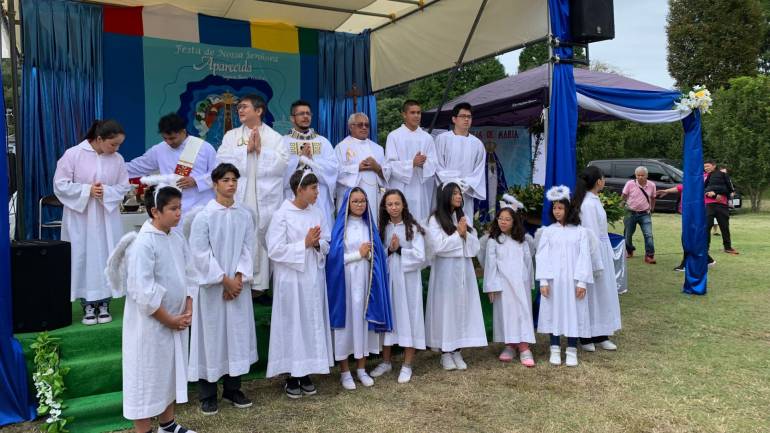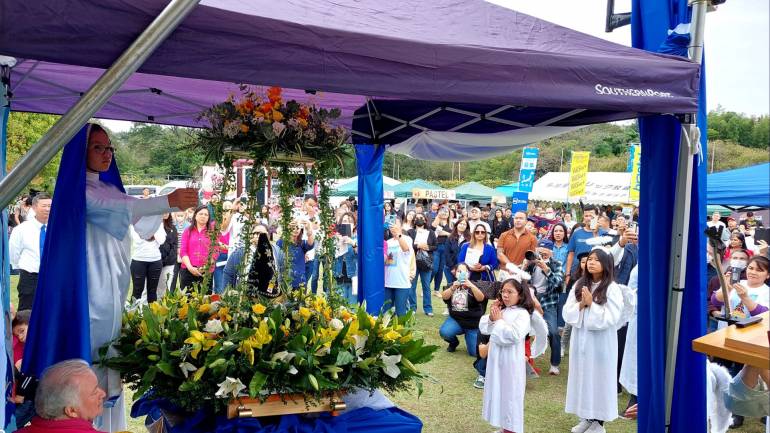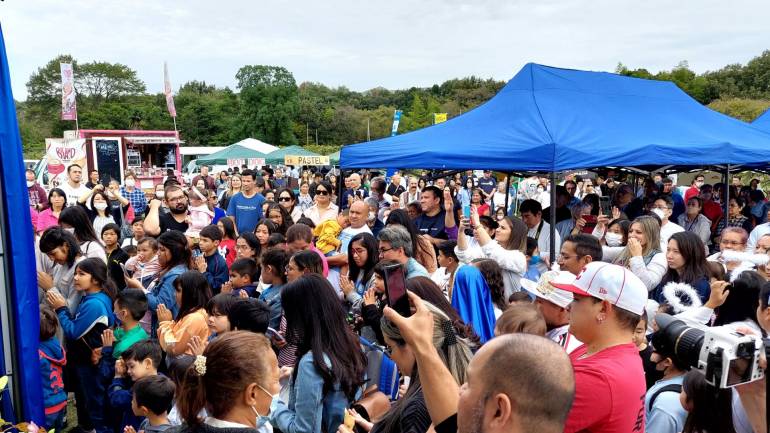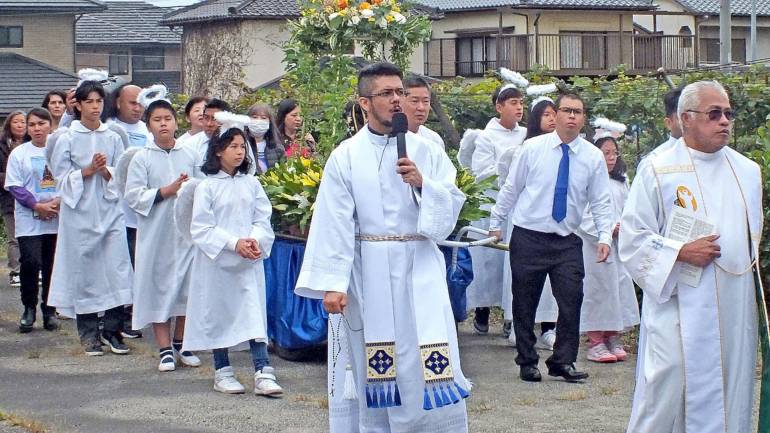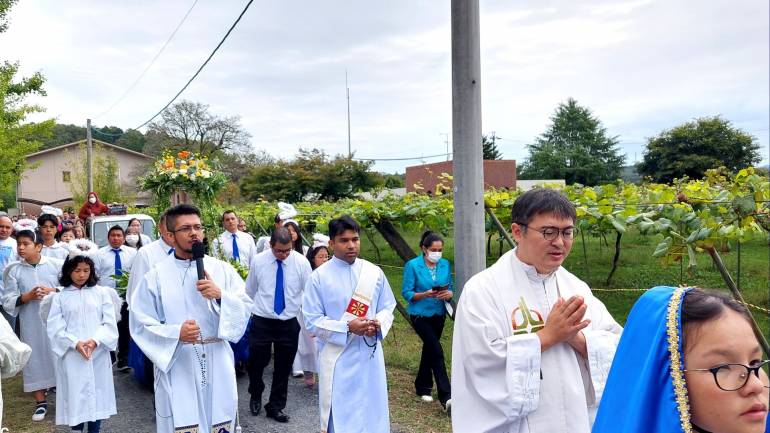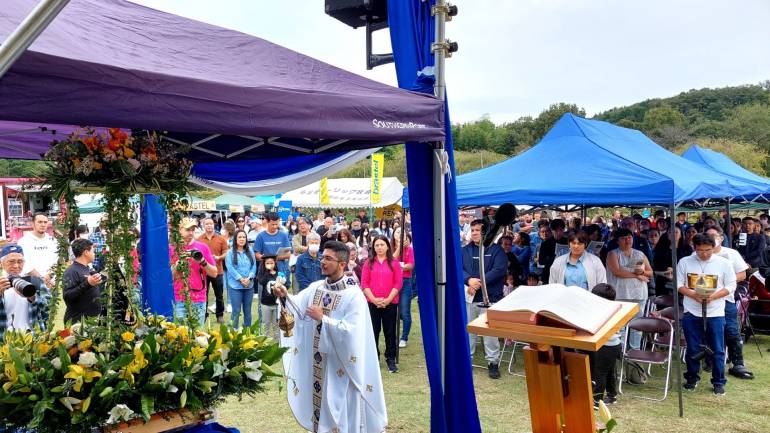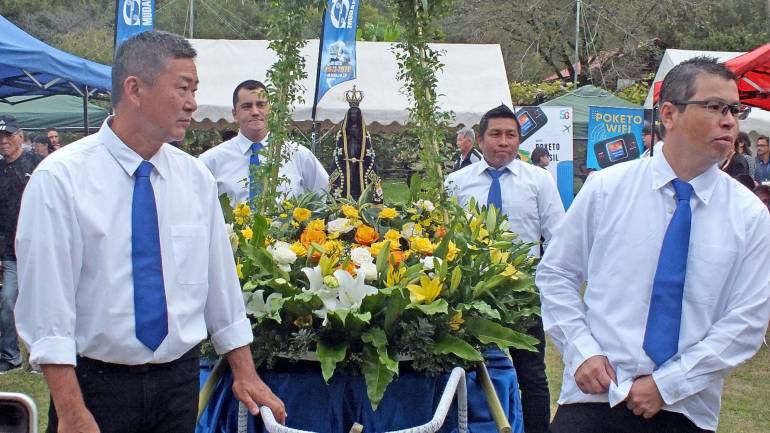Along the Mission Trail with Brazilian Migrants in Japan
The impetus to leave the enticing and bustling city of Cebu (minus, of course, the unsolved floodings causing the horrendous traffic jams!) in the evening of my life has raised numerous eyebrows. It was met with astonishment and endless queries from colleagues in the media bloc.
"Years in the broadcast ministry, and suddenly Brazilian migrants in Japan. How come? What is there in that? And complete with a jester too! “Magjapayuki ka didto,” teasingly quipped Engr. Mike Lurenana, a staunch supporter of the broadcast apostolate of the SVD Fathers over DYRF.
There seemed to be an absence of a mixture of hues to present a coherent portrait of a journey yet to be taken. So, they thought. And I simply couldn’t blame peers from the broadcast industry and former students from the University of San Carlos.
However, to the handful who, for decades, joined the bandwagon of my priestly vocation, it was no rocket science. They knew full well that after the dreaded COVID-19 pandemic, the apostolic detour was bound to happen. It was just a matter of time.
And finally, the dust of anxiety that hovered over the religious quest has settled. Now is the time to clear the cobwebs of nagging friends and acquaintances. The timing could not have been better to get a glimpse of a rare missionary journey. Perfect. More than a billion Catholics the world over celebrate World Mission Sunday (October 22, 2023). Nothing is happenstance.
Inception of a dream
The desire to dwell in the midst of Brazilian migrants in Japan was burning in my heart after my tenure as General Manager of Radio Veritas Asia (RVA). I was excited about the prospect of being missioned abroad after six years of directing the intercontinental RVA in the turbulent waters of the ever-changing media landscape.
But God had other plans beyond our poor minds to grasp. He sent out a red light. Not this time, Fr. Bob. His designs are often full of surprises. And in my case, it was a painful one, which ushered in a lot of questions! Yes, I questioned God Himself with eyes blurred with tears! But that is another story to tell.
The missionary aspiration didn’t come to fruition then, and with a sagging spirit, I found myself in Cebu. I was thrown back to radio work, which I would have gladly abandoned in lieu of the Brazilian migrants in Japan. But broadcast work kept me busy again, juxtaposed with teaching loads at the university. Reminiscing, there’s no denying that thriving in my comfort zone threatened the flame of a missionary dream.
Countless times! It became a flickering ember within as accolades mounted. But through it all, it was never extinguished or reduced to ashes. Not with time and age. It remained a beacon light, patiently waiting for a day when a wandering vessel would dock and anchor on its shores.
And the long wait came after the closing ceremonies of the 500 Years of Christianity, where the Diocese of Cebu was the primary host. I completed the requisite actions by composing and mailing the required documents. I prayed and waited in silence for God to listen to my longings. God sent His answers months later, but He outlined His own terms! I'm extremely appreciative that my superiors created a different blueprint with the help of His invisible hands.
They propounded that first I should sail for a year to the distant islands of Japan and “test the waters.” A remarkable change from a personal intent of immediate transfer to Japan for missionary endeavors Man proposes; God disposes!
God intervened, and it must be on target. Service is never outdated, and the timing to connect with the people I was so enamored with must be now. For nine long years, I roamed with the Brazilians in the mountains and rivers of the Amazon region. It was an experience that left an indelible mark and sparked a marvelous romance with Mother Nature.
The stand-alone privilege of traversing the tributaries of the mighty and muddy Amazon River. And what about the magnificence of having the endless canopy of green in the Amazon Forest as a roof and shelter? It was truly an exceptional and humbling experience!
Youkoso to Japan!
The Sakura season was waning when the plane touched down at Tokyo’s Narita International Airport in mid-April this year. There were indescribable feelings rambling within since the trip was to the airport, not for seminars and conventions as I’ve done in the past. It was a year-long missionary journey to delve into the migrant apostolate of the Divine Word Missionaries. A year-long religious sojourn with Brazilian migrants in the Land of the Rising Sun.
I have no idea what exactly awaits, other than the knowledge that there are thousands of Brazilian migrants in Japan. On the other hand, I constantly reminded myself of the Old Testament warning Yahweh has given to Moses: “Do not come closer... remove your sandals, for the place you are standing is holy ground.” (Ex. 3:5)) Every place of mission must be considered sacred because the Lord has been there before the missionary’s arrival. One must learn to tread gently. Always.
Hiragana and Katakana
“Ohayo gozaimasu!” Good morning! And of course, "Domo arigatou,” which I believe everybody knows: Thank you very much. Sadly, these are the only Japanese phrases I know by heart. Nihonggo is the daily language in all corners of Japan. And it goes without saying that it must be studied. Finding a Japanese soul that speaks fluent English is like looking for a needle in a haystack. Of course, I was bursting with enthusiasm to learn and study the language.
On the one hand, I was not perturbed because my work would be directly with the Brazilians. The Portuguese language is next of kin. I can converse with it fluently and write as well with ease.
The first order of the day was a crash course in Nihonggo. I attended a language school in Nagoya to learn Hiragana and Katakana characters for 3 months and 3 hours of classes each week. It was an elementary introduction to learning the Japanese writing system and memorizing everyday phrases. There are three kinds of characters in the Japanese language.
The two I already mentioned earlier, and the third is Kanji, which to this day I haven’t started learning yet. After finishing the crash course and dedicating hours to learning to write the syllabic alphabets of Hiragana and Katakana, I opted for a break. Kanji can wait for another day!
It's possible now to recognize and read the characters in Hiragana and Katakana, but still with difficulty. At least better than a blank tablet, as was the case at the onset. There are close to a hundred basic characters for the Hiragana and Katakana syllabaries alone. Kanji, which counts for thousands, is still not in the picture!
When we finished the crash course last July, fellow students agreed in unison that Nihonggo is totemo muzukashi!( very difficult!). However, some classmates enrolled for the next level after passing our exams, as it is obligatory to enter any university in Japan.
Brazilian migrants in Japan
Like other migrants in Japan, the Brazilians came to this land in search of greener pastures. They came to work to support their families back home. What is interesting is the link these two countries have compared to other migrant workers in Japan. Brazilians first welcomed the Japanese in 1908, when hundreds of mostly farmers from Okinawa arrived in their country.
They were hired as workers for the vast coffee plantation. Then coffee was the main export product of Brazil. And in the years after, thousands of Japanese immigrants relocated to Brazil. At present, Brazil has the highest number of Japanese nationals outside Japan.
Fast forward to today, and there is a turnaround of events. In 1990, the Japanese government authorized the legal entry of Japanese and their descendants from Brazil until the third generation. They were welcomed to fill labor shortages in Japan's shrinking workforce. In 2020, there were over 190,000 Brazilian nationals living in Japan, making them the second-largest foreign community in the country. Brazilians are particularly well represented in the agricultural and manufacturing sectors, where they play a vital role in the Japanese economy.
Today, there are over 300,000 Brazilians living in Japan, mainly as workers in factories. They came from various corners of the enormous country. In their midst, I find meaning in my ministry today as a Divine Word missionary.
Diocese of Nagoya
The Roman Catholic Diocese of Nagoya boasts of the inclusion of five prefectures (kind of a province in the Philippines context) in Japan: Aichi, Gifu, Ishikawa, Fukui, and Toyama. In this vast diocese, SVD missionaries provide for the spiritual needs of the numerous Brazilian communities. There is one Brazilian priest at the forefront of the work and four other missionaries, including myself.
Our spiritual journey with them is tailored in a special way since everybody is working on weekdays. In fact, multitudes are working even on weekends. Toyota Corporation and its numerous subsidiaries are the main employers. Nagoya, after all, is the birthplace of Toyota.
The work schedule of the migrants and the distance of their dwellings dictate the drafted pastoral plan. Lectures, seminars, workshops, Bible studies, etc. generally take place on weekends. Liturgical activities are held in churches strategically central to clustered communities. Big solemnities and feasts are often celebrated on open grounds to accommodate the throng of migrants in attendance.
There are also migrant communities that regularly rent space in buildings for their Sunday Masses due to the distance needed to reach the nearest church. A few Sundays ago, we congregated in the backyard of a church in Tajimi in reverence to the National Patroness of Brazil, Nossa Senhora de Aparecida. Hundreds participated in the Eucharistic celebration, punctuated with liturgical dances, a very long procession, and the coronation of Our Lady of Apparition.
Clash of cultures
The financial reward for the Brazilian migrants is understandably high, but it also comes with a price. Being uprooted from a country that loves to celebrate is a sting that Brazilian migrants must learn to live with. In their native Brazil, there are countless festivals and holidays throughout the year.
Weekends are always a time for relaxation with friends and family, always eager to find a reason for a party. And it is just impossible not to see a friendly football match on weekends in towns and cities. Here in this part of the world, one has to navigate gently through the Japanese culture, which is a complex union of tradition and modernity.
And the language system is another mountain to climb for Brazilians in general. And I could honestly sympathize with them! Marcelo Kohashi from Manaus, Brazil, who has been in Japan for more than ten years, commented once: "O Nihongo é muito dificil, mas no trabalho na fábrica também não precisa conversar.” Nihonggo is very difficult, but at work in the factory, there is no need to talk. In the end, silence at work is a virtue among thousands of migrant workers in big factories, not just with the Brazilians.
With this backdraft, counseling for the Brazilian migrants becomes an essential component of our missionary program. There are also visits to hospitals and homes for those who are sick. A special permit is needed to pay a visit to those incarcerated seeking spiritual guidance and sacramental services.
The link to the Brazilian Consulate proved indispensable in the past, according to Fr. Anselmo de Melo, SVD, who is at the helm of the migrant apostolate for the Brazilians in the Diocese of Nagoya. Together with him and Fr. Ronaldo de Oliveira, SVD, I listen to the dreams and aspirations—the joys and pains—of Brazilian migrants in Japan.
Challenges on the Road Ahead
I tried to painstakingly sketch on canvas answers to queries about my work in Japan. In truth, many things are still undone on the mission path. I have chipped in a mere iota to the endeavor, knowing mine won’t be a voice in the wilderness. Others will throw tiny pebbles, creating ripples that travel a long, long way. In the task at hand, I found an ally in the words of the renowned 19th-century English poet Christina Rossetti: “Can anything be sadder than work left unfinished? Yes, work has never begun.”
When I embarked on the mission trail, I believed I could learn something. The uncertainties that lay ahead did not deter the zeal to serve. There is just the need to move forward, one step at a time. Pope Francis sums it up splendidly in the title of his message for World Mission Sunday 2023: “Hearts on fire, feet on the move.” (cf. Lk 24:13-35)
Bishop Kenneth Edward Untener of Saginaw encapsulated exquisitely the call to carry on the missionary challenge in the last lines of his now-renowned Oscar Romero Prayer. May this prayer be ringing in our hearts, for it shall always be a cornerstone for any evangelizing task in years to come.
“It may be incomplete, but it is a beginning, a step along the way, an opportunity for the Lord’s grace to enter and do the rest.
We may never see the end results, but that is the difference.
between the master builder and the worker.
We are workers, not master builders, ministers, or messiahs.
We are prophets of a future not our own. Amen. “
*Fr. Bobby M. Ebisa, SVD, is a chaplain to the Brazilian migrants in Tokai City, Aichi, Japan.
Radio Veritas Asia (RVA), a media platform of the Catholic Church, aims to share Christ. RVA started in 1969 as a continental Catholic radio station to serve Asian countries in their respective local language, thus earning the tag “the Voice of Asian Christianity.” Responding to the emerging context, RVA embraced media platforms to connect with the global Asian audience via its 21 language websites and various social media platforms.





